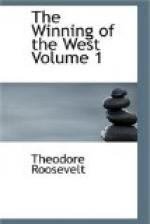of some of the rivers being well within that State;
and though the province was really part of North Carolina,
it was separated therefrom by high mountain chains,
while from Virginia it was easy to follow the watercourses
down the valley. Thus, as elsewhere among the
mountains forming the western frontier, the first
movements of population went parallel with, rather
than across, the ranges. As in western Virginia
the first settlers came, for the most part, from Pennsylvania,
so, in turn, in what was then western North Carolina,
and is now eastern Tennessee, the first settlers came
mainly from Virginia, and, indeed, in great part,
from this same Pennsylvanian stock.[3] Of course,
in each case there was also a very considerable movement
directly westward.[4] They were a sturdy race, enterprising
and intelligent, fond of the strong excitement inherent
in the adventurous frontier life. Their untamed
and turbulent passions, and the lawless freedom of
their lives, made them a population very productive
of wild, headstrong characters; yet, as a whole, they
were a God-fearing race, as was but natural in those
who sprang from the loins of the Irish Calvinists.
Their preachers, all Presbyterians, followed close
behind the first settlers, and shared their toil and
dangers; they tilled their fields rifle in hand, and
fought the Indians valorously. They felt that
they were dispossessing the Canaanites, and were thus
working the Lord’s will in preparing the land
for a race which they believed was more truly His
chosen people than was that nation which Joshua led
across the Jordan. They exhorted no less earnestly
in the bare meeting-houses on Sunday, because their
hands were roughened with guiding the plow and wielding
the axe on week-days; for they did not believe that
being called to preach the word of God absolved them
from earning their living by the sweat of their brows.
The women, the wives of the settlers, were of the
same iron temper. They fearlessly fronted every
danger the men did, and they worked quite as hard.
They prized the knowledge and learning they themselves
had been forced to do without; and many a backwoods
woman by thrift and industry, by the sale of her butter
and cheese, and the calves from her cows, enabled
her husband to give his sons good schooling, and perhaps
to provide for some favored member of the family the
opportunity to secure a really first-class education.[5]
The valley in which these splendid pioneers of our
people settled, lay directly in the track of the Indian
marauding parties, for the great war trail used by
the Cherokees and by their northern foes ran along
its whole length. This war trail, or war trace
as it was then called, was in places very distinct,
although apparently never as well marked as were some
of the buffalo trails. It sent off a branch to
Cumberland Gap, whence it ran directly north through
Kentucky to the Ohio, being there known as the warriors’
path. Along these trails the northern and southern
Indians passed and re-passed when they went to war
against each other; and of course they were ready
and eager to attack any white man who might settle
down along their course.




